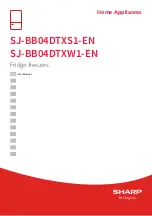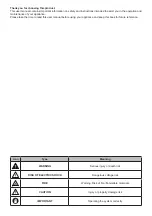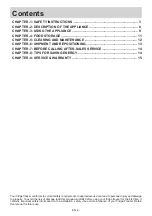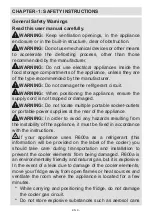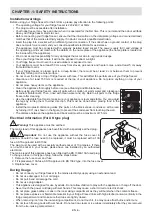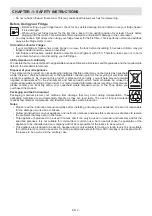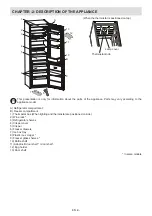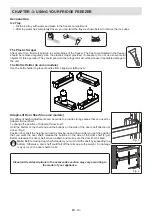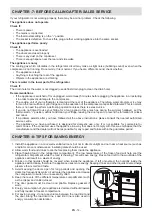
EN -11-
CHAPTER -4: FOOD STORAGE
Refrigerator Compartment
• To reduce humidity and avoid the consequent formation of frost, always store liquids in sealed containers in the
refrigerator. Frost tends to concentrate in the coldest parts of the evaporating liquid and, in time, your appliance
will require more frequent defrosting.
• Never place warm food in the refrigerator. Warm food should be allowed to cool at room temperature and should
be arranged to ensure adequate air circulation in the refrigerator compartment.
• Make sure no items are in direct contact with the rear wall of the appliance as frost will develop and packaging will
stick to it. Do not open the refrigerator door frequently.
• We recommend that meat and clean fish are loosely wrapped and stored on the glass shelf just above the
vegetable bin where the air is cooler, as this provides the best storage conditions.
• Store loose fruit and vegetable items in the crisper containers.
• Store loose fruit and vegetables in the crisper.
• Storing fruit and vegetables separately helps prevent ethylene-sensitive vegetables (green leaves, broccoli,
carrot, etc.) being affected by ethylene-releaser fruits (banana, peach, apricot, fig etc.).
• Do not put wet vegetables into the refrigerator.
• Storage time for all food products depends on the initial quality of the food and an uninterrupted refrigeration cycle
before refrigerator storage.
• To avoid cross-contamination do not store meat products with fruit and vegetables. Water leaking from meat may
contaminate other products in the refrigerator. You should package meat products and clean any leakages on the
shelves.
• Do not put food in front of the air flow passage.
• Consume packaged foods before the recommended expiry date.
NOTE
: Potatoes, onions and garlic should not be stored in the refrigerator.
Freezer Compartment
• The freezer is used for storing frozen food, freezing fresh food, and making ice cubes.
• To freeze fresh food, ensure that as much of the surface of the food as possible is in contact with the cooling
surface.
• Do not store fresh food next to frozen food as it can thaw the frozen food.
• Before freezing fresh food, divide it into portions that can be consumed in one sitting.
• Consume thawed frozen food within a short period of time after defrosting
• Never place warm food in the freezer compartment as it will thaw the frozen food.
• Always follow the manufacturer's instructions on food packaging when storing frozen food. If no information is
provided food, should not be stored for more than 3 months from the date of purchase.
• When purchasing frozen food, make sure that it has been stored under appropriate conditions and that the
packaging is not damaged.
• Frozen food should be transported in appropriate containers and placed in the freezer as soon as possible.
• Do not purchase frozen food if the packaging shows signs of humidity and abnormal swelling. It is probable that it
has been stored at an unsuitable temperature and that the contents have deteriorated.
• The storage life of frozen food depends on the room temperature, the thermostat setting, how often the door is
opened, the type of food, and the length of time required to transport the product from the shop to your home.
Always follow the instructions printed on the packaging and never exceed the maximum storage life indicated.
• The maximum amount of fresh food (in kg) that can be frozen in 24 hours is indicated on the appliance label.
• For optimum appliance performance to reach maximum freezing capacity, set the refrigerator thermostat at 4 - 5
for 24 hours before placing fresh food into the freezer.
• After placing fresh food into the freezer, change the setting to 4 - 5 for 24 hours is generally sufficient. After 24
hours, you can reduce the setting if required.
• To use the maximum capacity of the freezer compartment, use the glass shelves for the upper and middle section,
and use the lower basket for the bottom section.
• Use the fast freezing shelf to freeze home cooking (and any other food which needs to be frozen quickly) more
quickly because of the freezing shelf’s greater freezing power. Fast freezing shelf is the bottom drawer of the
freezer compartment.
NOTE:
If you attempt to open the freezer door immediately after closing it, you will find that it will not open easily. This
is normal. Once equilibrium has been reached, the door will open easily.
Important note:
• Never refreeze thawed frozen food.
• The taste of some spices found in cooked dishes (anise, basilica, watercress, vinegar, assorted spices, ginger,
garlic, onion, mustard, thyme, marjoram, black pepper, etc.) changes and they assume a strong taste when they
are stored for a long period of time. Therefore, add small amounts of spices to food to be frozen, or the desired
spice should be added after the food has thawed.
• The storage time of food is dependent on the type of oil used. Suitable oils are margarine, calf fat, olive oil and
butter. Unsuitable oils are peanut oil and pig fat.
• Food in liquid form should be frozen in plastic cups and other food should be frozen in plastic folios or bags.
Summary of Contents for SJ-BB04DTXS1-EN
Page 1: ...Home Appliances Fridge freezers SJ BB04DTXS1 EN SJ BB04DTXW1 EN User Manual EN ...
Page 2: ......
Page 18: ......
Page 19: ......
Page 20: ...Service Support Visit Our Website sharphomeappliances com 52288544 ...

